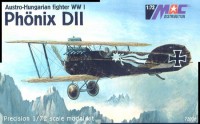|
Aircraft kits / 1:72 / Phoenix D.II Phoenix D.II

Code: 72036
Austro-Hungarian WWI Fighter
The robustly-built fighter biplane Phoenix D.I was produced by Phoenix
Flugzeugwerke AG, Wien´s aircraft factory. It was derived in the middle of 1917
year from the licence-built Hansa Brandenburg D.I type by the Phoenix design
department, guided by Diplom-Ingenieur Leo Kirsten. Wing system was created by
Diplom-Ingenieur Edmund Sparman, Austria prewar pilot and designer.
The wooden fuselage was derived from the Hansa Brandenburg D. I but it was a few
inches longer to accommodate the 200hp Hiero engine. Armament consisted of twin
synchronized Schwarzlose 8.8 mm machine guns. There were mounted well forward
alongside the engine. Inward-sloping wing struts were typical for Sparman-designed
wing cellule. Flight comparsions performed in September 1917, showed that
Phoenix D.I was faster in speed and climb than the Albatros D.III and possessed
better flight characteristics than the Aviatik (Berg) D.I.
There were ordered three series of the Phoenix D.I type, which were differed by
three engine manufacturers: Eisler, Warchalowski and Co, Austro-Fiat Werke (Fi)
and Maschinenbau AG Breitfeld, Danek and Co (Bd). The numbers assigned were:
Phoenix D.I 128.01 to 128.31 200hp Hiero
Phoenix D.I 228.01 to 228.55 200hp Hiero(Fi)
Phoenix D.I 328.01 to 328.34 200hp Hiero(Bd)
Series manufacture began in August 1917 and was scheduled to the end of December,
but the first machines were accepted by the Luftfahrtruppe (Austro-Hungarian
aviation troops) in October 1917 and the last in May 1918.
Beginning December 1917 the Phoenix D.I was flown as an escort fighter of two
seaters scouts and as a fighter. A number of them were converted on photo-reconnaissance
machines. Some were fitted with a 230hp Hiero engine.
Phoenix D.I fighters became a quite popular planes in operational use. There
were easy to fly and especially two-seater pilots experienced little difficulty
in making transition to the Phoenix single-seater. Also the robustly-built
Phoenix D.I possessed no hidden vices and unlike the Aviatik (Berg) D.I, could
dive at high speed without fear of structural failure. But many fighter pilots
had different opinions: The speed and climb of Phoenix D.I was inferior to the
Nieuport, Spad and Sopwith fighters and there were too stable for quick combat
maneuvers. Nevertheless many Austro-Hungarian fighter aces flew this type: eg.
Frank Linke-Crafword, Kurt Gruber, Roman Schmidt and Karl Urban. Twenty Phoenix
D.I fighters served in Austro-Hungarian Naval Service for defense of naval bases.
About 70 machines were still in the operational service on August 1918.
For more information we recommend:
• Windsock Datafile No. 31 "Phoenix D.I - D.II" by Peter M. Grosz.
Published by Albatros Publications, 1992, ISBN 0-98414-37-5
• Austro-Hungarian Army Aircraft of World War One by Grosz, Haddow and Schiemer.
Published by Flying Machines Press, 1993, ISBN 0-9637110-0-8
• Air Aces of the Austro-Hungarian Empire 1914-1918 by Dr. Martin O'Connor.
Published by Flying Machines Press, 1986, ISBN 0-9637110-1-6
Top
|
Pictures
Assembly instructions
Camouflage scheme
Clear foil
Decals
Photoetch
|